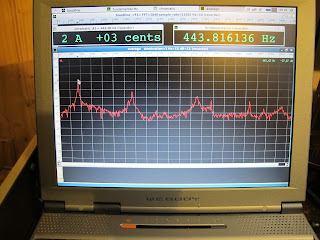Here's a little video on how to tune a resonator tube using wax.
Documenting the process of building a 3 octave marimba. I'm not to be held responsible for any offsite links. Your safety when working with tools is entirely YOUR responsibility, not mine. Have fun!
Saturday, 14 May 2016
How to tune a resonance tube with wax
Here's a little video on how to tune a resonator tube using wax.
Monday, 9 May 2016
Cutting...grey flakes.
This afternoon saw the resonator tubes cut to length. Only point to note was that I had to use the length one semitone up compared to the lengths stated in Jim's description (e.g., length for c used for c#). One reason for this is the tuning frequency of 443Hz, and the other is my plan to use wax inside the tube (shortening the tube to pitch) whereas Jim uses a cap on the outside (lengthening the tube to pitch).
So here they are:
Next steps: Bevel the ends and paint in piano black.
Stay in l/4 resonance ;)
So here they are:
Next steps: Bevel the ends and paint in piano black.
Stay in l/4 resonance ;)
Thursday, 5 May 2016
On a budget? - Take spruce!
Just for fun, I made a bar usingf spruce, at a4=443Hz. I knew from my first experiments with the router that the spruce bars sounded very nice, even better than birch. So if you're on a budget, you can very well take spruce IMHO. It should be dry, and of decent quality, with few (if any) knotwholes.
Here is the complete process of cutting and tuning the bar in pictures. It took about an hour to complete the bar.
This is the raw bar, cut to length. I did not adjust the length to the lower density of the spruce; if you're planning to build an instrument, I'd recommend adapting the thickness. The length of the bar should be aligned with the grain of the spruce.
The piece of wood has its fundamental at almost and octave higher.
After bevelling the top lengths of the bar and sanding, the measurment shows little change.
Hey, haven't seen you in a while, Robo Router ;). At the first cut, I (impatiently!!!) removed 6mm deep of wood....
...which was already too much for the second overtone! The fundamental is at Eb, way above target.
The 2nd overtone at 2 octaves above (4 * 443 = 1772HZ) is already too low. That's why you should not be impatient when tuning marimba bars!
There is a third overtone, but I do not intend to tune this bar at the third overtone.
Again, Bork's diagram is a great help to decide where to remove material.
First, some material influencing the fundamental only was removed.
After some more iterations of removing material (<10), the fundamental is spot on.
Fundamental at 443,
second overtone too low at G#, which will result in a "tingling" sound;
third overtone somewhere, I don't care ;).
The shape of the grooves can clearly be seen against the background of the screen.
Here is the complete process of cutting and tuning the bar in pictures. It took about an hour to complete the bar.
This is the raw bar, cut to length. I did not adjust the length to the lower density of the spruce; if you're planning to build an instrument, I'd recommend adapting the thickness. The length of the bar should be aligned with the grain of the spruce.
The piece of wood has its fundamental at almost and octave higher.
After bevelling the top lengths of the bar and sanding, the measurment shows little change.
Hey, haven't seen you in a while, Robo Router ;). At the first cut, I (impatiently!!!) removed 6mm deep of wood....
...which was already too much for the second overtone! The fundamental is at Eb, way above target.
The 2nd overtone at 2 octaves above (4 * 443 = 1772HZ) is already too low. That's why you should not be impatient when tuning marimba bars!
There is a third overtone, but I do not intend to tune this bar at the third overtone.
Again, Bork's diagram is a great help to decide where to remove material.
First, some material influencing the fundamental only was removed.
After some more iterations of removing material (<10), the fundamental is spot on.
Fundamental at 443,
second overtone too low at G#, which will result in a "tingling" sound;
third overtone somewhere, I don't care ;).
The shape of the grooves can clearly be seen against the background of the screen.
The sound is mellow, with a relatively short decay time compared to the Padouk bars. But for a little 1 octave, maybe pentatonic instrument on a budget, mounted over a box resonator, the sound is definitely all right!
Subscribe to:
Comments (Atom)














